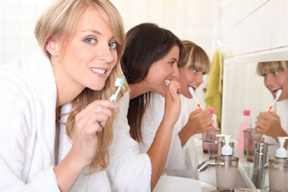 WASHINGTON: If you are using a shared washroom there is a 60 per cent chance your toothbrush is covered in fecal matter from someone else, a new study suggests.
WASHINGTON: If you are using a shared washroom there is a 60 per cent chance your toothbrush is covered in fecal matter from someone else, a new study suggests.
Data confirms that there is transmission of fecal coliforms in shared bathrooms and that toothbrushes can serve as a vector for transmission of potentially pathogenic organisms, researchers said.
“The main concern is not with the presence of your own fecal matter on your toothbrush, but rather when a toothbrush is contaminated with fecal matter from someone else, which contains bacteria, viruses or parasites that are not part of your normal flora,” said Lauren Aber, graduate student at the Quinnipiac University in US.
Potential microorganisms that can be introduced are enteric bacteria and pseudomonads. Enteric bacteria are a family of bacteria, Enterobacteriaceae, they are known to be normal flora found in the gut.
Pseudomonas group of bacteria are gram-negative aerobic rods commonly found in soil, water, plants and animals. They are part of the normal flora of the gut and also on the skin of humans.
All toothbrushes were collected from participants using communal bathrooms, with an average of 9.4 occupants per bathroom.
Regardless of the storage method, at least 60 per cent of the toothbrushes were contamination with fecal coliforms.
There were no differences seen with the effectiveness of the decontamination methods between cold water, hot water or rinsing with mouthwash and 100 per cent of toothbrushes regularly rinsed with mouthwash had growth on MacConkey agar indicating fecal contamination.
Fecal coliforms were seen on 54.85 per cent of toothbrushes, which has been seen in previous studies. There is an 80 per cent chance that the fecal coliforms seen on the toothbrushes came from another person using the same bathroom.
“Using a toothbrush cover doesn’t protect a toothbrush from bacterial growth, but actually creates an environment where bacteria are better suited to grow by keeping the bristles moist and not allowing the head of the toothbrush to dry out between uses,” said Aber.
“Better hygiene practices are recommended for students who share bathrooms both in the storage of their toothbrush but also in personal hygiene,” said Aber.
Toothbrushes are a known source of contamination. Since the 1920’s scientists suspected that the re-use of toothbrushes could be a possible source of infection in the oral cavity.
There are several potential sources of contamination of one’s toothbrush; toothbrushes stored open in the bathroom are especially vulnerable to contamination with material from the toilet or contamination from other occupants. -PTI






